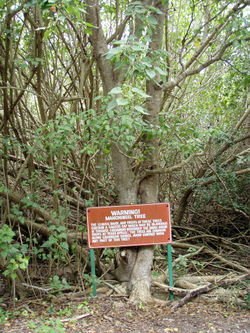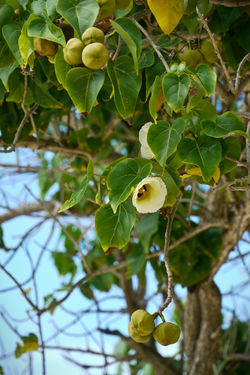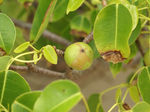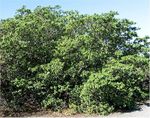Manchineel
| Manchineel |
|---|

|
| Scientific Classification |
|
| Scientific Name |
|
Hippomane manchineel |
| Manchineel tree |
The manchineel tree is the most poisonous tree in the world. According to historical accounts, when Christopher Columbus' men visited the virgin islands in 1493, they encountered this tree, so some of them tried it, they shouldn't have. DO NOT EAT FROM THIS TREE! Long ago Indians would tie people to this tree to torture them. You cant touch the bark or stand beneath this tree.[1]
This tree is rumored as the tree that killed the famous explorer Juan Ponce De Leon. Do you know the name of the tree that the Spanish dubbed manzanilla de la muerte is also called the little apple of death? Other names include the beach apple, death apple, and the death guava. The milky white sap can also kill you. It causes skin irritation and burns. If you burn this tree make sure you don't get any smoke into your eyes. [1]
Body Design
The manchineel is a handsome, round-crowned tree that grows up to 12 meters in height and 60 centimeters in diameter. It has long stocked elliptic yellow-green leaves. The manchineel is very poisonous. The fruit looks like apples , but do not eat them because if you do you will die. The fruit contains 6 to 9 seeds. It has a sticky white sap that can also kill you. The trees wood, with a good polish, can be used for furniture. The tree looks like a tree you would find on a beach, although the bark may look a little moldy.[2]
The manchineel is an evergreen tree. The leaves are simple, alternate, and finely serrated or toothed, and they are about 5 to 10 centimeters long. spikes of small greenish flowers are followed by fruits. The bark is reddish to grayish-brownish. It is deeply furrowed and cracked looking. The fruit is 1 to 2 inches in diameter. The manchineel is usually found as a tall shrub, but it has been found to grow up to 50 feet tall. Each leaf has a small gland where the leaf joins the stem. [3]
Life Cycle
The manchineel tree is a perennial plant that requires full sun to partial shade. it prefers wet mesic water. It reproduces by seeds in the apple like fruits. They can grow up to fifty feet tall by the time they reach maturity. As the plant grows its underground taproot structures grow with it. [4]
Ecology
This tree is found on the coast of Florida, the Keys, the Caribbean, and Central America. It typically occurs along the seacoasts and brackish swamps where it grows among the mangroves. It is a rare tropical plant. Many are labeled with warning signs. [3]
The tree grows along to coastal beaches of the West Indies, and in saline waters with mangroves. The tree isn't as abundant or as highly encountered as mangroves. On the other side it is highly endangered.[5]
Toxicity
This tree is the most toxic tree in the world. The fruit is reportedly juicy and quite tasty when ripe, but don't let that fool you, DO NOT EAT THE FRUIT! The fruit of this tree is loaded with physostigminet,a compound that is the active ingredient of the Calabar bean and is used medicinally in eye drops because of its anticholinergic activity. . That is not something you want to ingest carelessly. Eat just a bit of the fruit, as many tourists have done, and it will result in pain and swelling of the mouth and throat. If you eat a good bit of if you will have the same fate as someone exposed to nerve gas. The oral swelling and excruciating pains, esophageal ulcerations, edema, and cervical lymphadenopathy will make it hard to breathe, almost impossible to swallow, and very difficult to talk.[1]
Video
This is a warning video of the extremely toxic manchineel tree. Listen to its wise warnings.
References
- ↑ 1.0 1.1 1.2 Author unknown. National Park Mystery Plant 2: There’s Good Reason They Call This Thing "the Death Apple” Publisher site name. Web. accessed February 1, 2018.
- ↑ Manchineel britannica. Web. last modified December 08, 2017. author unknown
- ↑ 3.0 3.1 Michael G. Andrew Hippomane mancinella, Manchineel1 University of Florida IFAS Extension. Web. uploaded July, 2012.
- ↑ author unknown. Manchineel (Hippomane mancinella) garden.org. Web. accessed February 1, 2018.
- ↑ peshin, akash. The Manchineel Tree: How Even Standing Near The ‘World’s Most Dangerous Tree’ Could Kill You. scienceABC. Web. accessed january 31, 2018.



